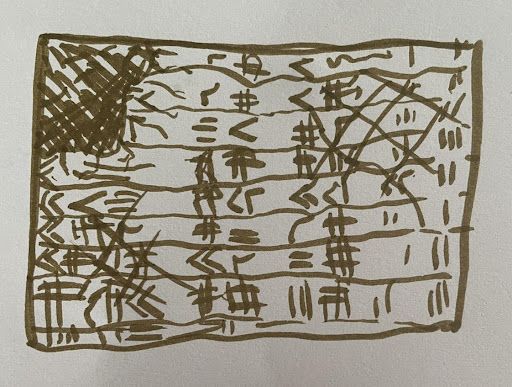The Abacus

Once upon a time, you existed. Every day, you lived your ordinary life. One day, you woke up in another dimension where people couldn't count. The portal to your escape was on the other side of the world of this dimension. Because of that, you tried arranging a trip there, only to realise the internet can't exist in a world where people don't know how to count. Because of that, you tried searching for a ship until you realised the formulae required to engineer a complex one wouldn't exist in this universe. Therefore, there are no ships. Because of that, you tried to build your own ship, but when you had finished collecting wood, you had forgotten how to count, disabling you completely. Finally, an IDFC employee comes and rescues you, which leads you to learn the moral of the story: society as we know it wouldn't be able to exist if we didn't know how to count. And then, the author uses this as a ramp to point out how primitive early maths was and how difficult it must be to imagine a world like it.
Ages of Abaci
“Hey there! If you’ve received this letter, you’ve been involved in a mistake in interdimensional transactions. In other words, you’re in another dimension!
We apologise for the inconvenience and will send one of our employees to pick you up as soon as possible. Here are a few things you need to know about the dimension you’re in:
- Humans don’t know how to count here. They can’t do anything from the most complex equation ever conceived and beyond knowing about the existence of the number one!
- If you want to leave this dimension on your own, we have installed a portal on Salamis Island for your convenience. You can find it on the map accompanying the letter!
- Be warned, if you stay in a dimension long enough, its features will start to rub off on you. Depending on which dimension it is, this can be very bad!
Stay safe!
The IDFC (Interdimensional Foreign and Commonwealth) Team”
This is the letter you find on your lap after waking up on a bed that’s definitely not yours in a straw hut you would never have chosen yourself to a stench of animal dung that confirms this isn’t just a dream. You immediately look at the map: there is no way you are leaving your rescue to a company that can’t even make sure you’re in your own universe. “Guy Who Invented Abacus” is all the way on the other side of the world? No problem, phones are there for a reason.
You are just about to find Salamis Island’s number when you wonder, do phones exist in this dimension? You learned about binary code in school, and binary code can’t exist in a place where people can’t count to one, so can any type of digital computer exist? Can all the other calculations required to make a computer exist? There are no computers here, no iPhone or Harwell Dekatron. There is no internet here. You can’t rely on it anymore.
You think of the second key to your escape, ships. You dash out of your hut and run to the beach, but when you reach it, there’s no port. You walk the perimeter of the whole island. Nothing. Then it hits you: there are no ships. Small rowboats exist, but the equations needed to build a more complex one are lost forever. And the only map in the whole world, you realise, is the one you’re carrying with you right now because people couldn’t make a proper map if they had no idea about measurements, ratios, and coordinates.
So, the only escape path is on the other side of the world, and there’s no vessel that can take you there. Well then, you’ll just have to make one. You make a blueprint of a ship, figure out how much wood is required, run to the hut, find a rather primitive axe, then dash into some woodlands and get chopping.
When you’re done, morning has turned to noon to evening. You sit on a stump for a while as thoughts flicker through your head, like how when you get back home, your story is going to make you famous, and how that stench of animal dung probably came because the owners of those animals had no idea to manage them; they had no idea how to count and-
Counting
Counting, what does that word mean? Well, you don’t know, but it feels like it was important.
You instinctively grab the map. It makes no sense to you. You try the blueprint. No luck. And suddenly, you’re standing in front of a pile of wood the size of a small hill in front of you, and you have no idea what to do. You needed to figure out how... how m... there’s an “m” word that you can’t think of, each part of the ship needed. Now you can’t. You will look back on this experience and realise that at that point, you wouldn’t know the difference between one plank and two.
Feeling all hope is lost, you mope back to the hut and collapse on the bed, weeping. Fortunately, a uniform-clad lad appears in about an hour or so, says he’s an IDFC employee and that he’s come to take you home, and you return to Earth together. You remember everything about the past two decades of maths education you suffered, and everything from your engineering degree, and feel relieved that your parents can’t whoop your butt for forgetting them.
You log into your computer and scroll for a bit until you come across this article, which you are reading right now.
I wrote that labyrinthine introduction to make a point: civilisation as we know it couldn’t exist if we didn’t know how to count. While the world’s numerical prowess has never been as bad as I’ve described in the introduction, the progress we’ve made would be staggering to those living in ancient times. In the modern age, we have devices that fit in our hands that can calculate almost any equation we can think of. Back then, there was a time when the way we write numbers (The Hindu-Arabic numeral system) didn’t exist. Even the world’s brightest minds wouldn’t have known about place value, something every first grader knows today. So, back then, how did people keep track of numbers? How did people count?
One of the ways that people did it was by the abacus. A simple device you may have held in your primary school, a frame on which beads are slid to represent numbers and place values. Child’s play. Before the Hindu-Arabic numeral system came to be, however, this device was used by people worldwide to count in places as diverse as Mesopotamia, Greece, Egypt, Rome, and Native America. In this article, I’m going to take a look at the ages of abaci.
Mesopotamia
Here is my “”artist’s’’’’ of a Mesopotamian abacus:
Mesopotamian abaci worked on a sexagesimal, or base 60 number system. The name says it all: it’s a number system based on 60, just like the 60-hour clock.
Greece and Egypt
I was able to find one source for both of these abaci: the historian Herodotus, also known as “The Father of History”. He wrote that the Greeks manipulated the abacus from left to right while the Egyptians manipulated it from right to left. Speaking of Greece, the oldest discovered counting board is currently.
The Salamis Tablet
which was found on the Greek Island of Salamis in the year 1846. It is thought to date back to 300 BC.
China
The Chinese abacus is called a suanpan, which is written as 算盤 or 算盘 in Chinese. This is what one looks like:
The method of counting on this abacus is simple. Do you see the beam inside the abacus? The values of the beads which are moved toward it are counted, while the values of the ones which aren’t moved towards the beam are not. Each of the beads in the upper section has a value of five, while each of the beads in the lower section has a value of 1.
Japan
Japanese abaci are called sorobans, and the word “soroban” is written as そろばん in Japanese. It is thought to have been introduced in China in the Muromachi era. Here is (an attempt at) a drawing of one:
Sorobans are quite similar to their suanpan counterparts, but sorobans have one bead in the upper section of each column, and on a soroban, decimal values can be represented.
For something to become normal, it has to start off abnormal. And it can be very, very easy to forget that this applies to everything in our lives. Things as simple as languages and the creation of fire and the Hindu-Arabian counting system were all complicated and new once upon a time. I hope that now you will look upon the way people counted before counting as we know it existed: the abacus, with more awe and wonder than you did before.
References
Smith, David Eugene (1958). History of Mathematics. https://archive.org/details/unset0000unse_w3q2-,
Dover Books on Mathematics. Vol. 2: Special Topics of Elementary Mathematics. Courier Dover Publications. ISBN 978-0-486-20430-7,
Pullan, J. M. (1968). The History of the Abacus. New York, NY: Frederick A. Praeger, Inc., Publishers. ISBN 978-0-09-089410-9. LCCN 72075113, https://web.archive.org/web/20141226170451/http://www.ee.ryerson.ca:8080/~elf/abacus/intro.html, http://tsm.tsinghua.edu.cn/?p=2769,
Gullberg, Jan (1997). Mathematics: From the Birth of Numbers. Illustrated by Pär Gullberg. New York, NY: W. W. Norton & Company. ISBN 978-0-393-04002-9. https://www.csmonitor.com/1982/0720/072033.html.
https://archive.org/details/unset0000unse_w3q2-, Smith, David Eugene (1958). History of Mathematics. Dover Books on Mathematics. Vol. 2: Special Topics of Elementary Mathematics. Courier Dover Publications. ISBN 978-0-486-20430-7, Pullan, J. M. (1968). The History of the Abacus. New York, NY: Frederick A. Praeger, Inc., Publishers. ISBN 978-0-09-089410-9. LCCN 72075113, https://web.archive.org/web/20141226170451/http://www.ee.ryerson.ca:8080/~elf/abacus/intro.html, http://tsm.tsinghua.edu.cn/?p=2769, Gullberg, Jan (1997). Mathematics: From the Birth of Numbers. Illustrated by Pär Gullberg. New York, NY: W. W. Norton & Company. ISBN 978-0-393-04002-9. https://www.csmonitor.com/1982/0720/072033.html.
Author Biography
Mishka is an ordinary high-school student who thinks that there is no point in making yourself look more professional than you really are and believes in this law that she made up, which says: “If thou must describe thyself as something, thou art almost certainly not that something.” (e.g., humble people don’t tell other people that they’re humble). This law is not part of her identity; she put it here to clarify why this bio is the way it is. She likes puzzles, paradoxes, and books. She likes some people too, and she likes keeping her relationships with those people private. She dislikes the fact that she’ll never know the full truth of anything. She lives in the Maldives with her mum, dad, some fictional characters, and three hamsters: Jingo, Baloo, and Icarus. There used to be a fourth, Reepicheep, but she is thought to have skydived off the balcony.

Cite this article as:
Mariyam Mishka Migdhaadh, The Abacus, theCircle Composition, Volume 2, (2022). https://theCircleComposition.org/the-abacus/
